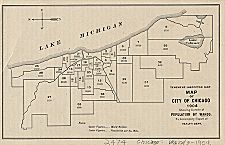| Entries |
| W |
|
Ward System
|

|
Chicago is unusual in having maintained its ward system while many cities were experimenting with at-large voting systems, smaller councils, and nonpartisan elections. Besides being a device of representative government, wards have organized residents' access to city services and, for an earlier generation, shaped the ward-and-precinct structure of political parties. In some cases, wards have developed localized cultural identities akin to those of neighborhoods.
Bibliography
Karlen, Harvey M.
The Governments of Chicago.
1958.
Pierce, Bessie Louise.
A History of Chicago.
3 vols. 1937–1957.
Sparling, Samuel Edwin.
Municipal History and Present Organization of the City of Chicago.
Bulletin of the University of Wisconsin, no. 23, May 1898.
The Electronic Encyclopedia of Chicago © 2005 Chicago Historical Society.
The Encyclopedia of Chicago © 2004 The Newberry Library. All Rights Reserved. Portions are copyrighted by other institutions and individuals. Additional information on copyright and permissions.
The Encyclopedia of Chicago © 2004 The Newberry Library. All Rights Reserved. Portions are copyrighted by other institutions and individuals. Additional information on copyright and permissions.